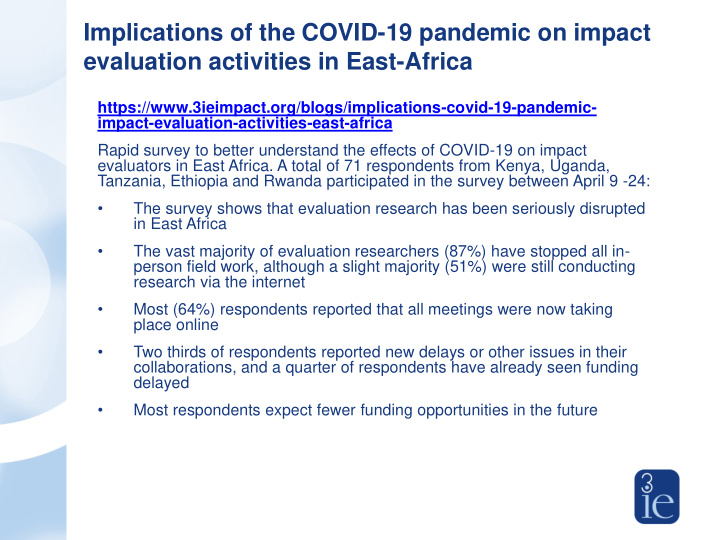



Implications of the COVID-19 pandemic on impact evaluation activities in East-Africa https://www.3ieimpact.org/blogs/implications-covid-19-pandemic- impact-evaluation-activities-east-africa Rapid survey to better understand the effects of COVID-19 on impact evaluators in East Africa. A total of 71 respondents from Kenya, Uganda, Tanzania, Ethiopia and Rwanda participated in the survey between April 9 -24: • The survey shows that evaluation research has been seriously disrupted in East Africa • The vast majority of evaluation researchers (87%) have stopped all in- person field work, although a slight majority (51%) were still conducting research via the internet • Most (64%) respondents reported that all meetings were now taking place online • Two thirds of respondents reported new delays or other issues in their collaborations, and a quarter of respondents have already seen funding delayed • Most respondents expect fewer funding opportunities in the future
1. Safeguarding and ethical aspect • https://ieg.worldbankgroup.org/blog/adapting- evaluation-designs-times-covid-19-coronavirus- four-questions-guide-decisions • https://ieg.worldbankgroup.org/sites/default/files/D ata/Blog-images/Covid_Eval_DecisionTree.pdf • https://www.3ieimpact.org/blogs/phone-surveys- developing-countries-need-abundance-caution
2. The research and methods aspect • Share! Effect estimates are not the only valuable thing! The data you collect can have real value to governments and implementers. National Rural Livelihoods program, India • Mitigate ! On the ground collection of data infeasible: carefully monitor the state of program implementation and overall situation to retain the validity of research when you can resume Aquaculture program, Bangladesh • Adapt! Can you work better with your local partners? Can you do virtual fields visits? Can you do the survey by telephone? Sustainable Livelihoods program, Philippines • Innovate! Use alternative sources of data, e.g. big data
The map
Included studies across data sources Number of Impact Number of Data Source Evaluations Measurement Studies Human-Sourced Data 0 18 Social Networks Internet Searches 0 11 2 10 Mobile Data Content 2 10 Citizen Reporting or Crowdsourced Data Process-Mediated Data 1 2 Data Produced by Public Agencies Data Produced By Businesses 2 7 0 65 Cell Phone Call Record Details Machine-Generated Data 7 32 Data from Fixed Sensors Data from Mobile Sensors (Tracking) 0 15 39 270 Data from Satellites Total 48 381
Key findings • Satellite images and mobile call detail records are the most used big data sources. • The development themes studied the most include: – Environmental sustainability – Economic development and livelihoods – Urban development – Health and well-being – Energy, industry and infrastructure provision • While there are a number of studies that have used big data for measuring various development outcomes, there are not many impact evaluations that have used these innovative big data-based outcome measures. • This indicates the opportunity for incorporating big data measures in impact evaluations to measure the impact at higher frequency and granularity.
3. Better use of existing evidence • Use existing evidence better and creatively! • https://developmentevidence.3ieimpact.org/ 3759 IEs; 730 SRs; 20 EGMs • #2020Hindsight campaign: e.g. handwashing blog https://www.3ieimpact.org/blogs/how-get-people- wash-their-hands • Explosion of COVID-19 focused research (and duplication of efforts) requires systematic reviews (Campbell, IDCG/3ie) • Evidence Synthesis Response to the ongoing global crisis: 3ie /Africa Centre for Evidence (ACE) /Global Evidence Synthesis Initiative (GESI) https://www.surveymonkey.co.uk/r/2DH7QGM
Recommend
More recommend